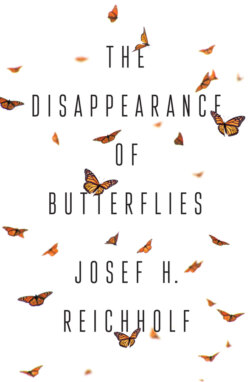The Disappearance of Butterflies

Реклама. ООО «ЛитРес», ИНН: 7719571260.
Оглавление
Josef H. Reichholf. The Disappearance of Butterflies
Contents
Guide
Pages
The Disappearance of Butterflies
Foreword
Acknowledgements
Introduction
A Review of 50 Years of Butterfly and Moth Research
Insects fly towards UV light
Urban Lepidoptera: more common than expected
Death’s head hawk-moth: a guest that can barely live with us anymore
The Fascinating Life of Aquatic Moths
Evenings at the pond
The hidden lives of the little nymphs
How the caterpillar breathes under water
Up and away in an air balloon
The advantages of living in water
A place to live or an ‘ecological niche’
The destruction of the biotopes of the little nymphs
The Benefits of Being Attracted to Light
Like moths to a flame
The red blindness of butterflies
The Strange Behaviour of the Purple Emperor
Butterflies on drugs
Psychedelics in the insect kingdom
The Nettle-feeding Lepidoptera: An Instructive Community
Nettles: indicators of overfertilization
Nettles escape defoliation
Maize: damaged beyond repair
Cabbage whites: parasites and protection
The mass flight of the map butterfly: singularities in the realm of the butterflies
Does climate change affect the seasonal morphs of the map butterfly?
Nature is too diverse for simple generalizations
The Great Migrations of the Butterflies
The migratory flights of the painted ladies
Small tortoiseshells as travellers
Butterfly invasions
Poisonous Butterflies and Moths: From the Cabbage White to the Six-spot Burnet
Cabbage whites on the Dalmatian coast
Whenever it rains in the desert …
Which factors affect the reproduction of butterflies, and when?
Useful models
The need to go slow
Poison in the body
The Secret Life of Small Ermine Moths
The bird-cherry, a tree of the riparian woods
Toxins in bird-cherries
The life history of the caterpillars of the ermine moth
Helpful hungry caterpillars*
Between parasitism and population explosion
Longer-term population cycles
Coppice management and its consequences
Generations and multiyear cycles of ermine moths
Parasitoids on other ermine moths
The lifecycles of butterflies and moths
Hardy Winter Moths
Life at the edge of winter
The mastery of seasonal niches
Why female winter moths do not need wings
Deforestation, poison and the decline of the codling moth and the winter moth
The common quaker moth in early spring
Brimstones: The First Spring Butterflies
Butterfly attacks
The problem with early flight
Müllerian mimicry
The critical factor of spring weather
‘Balance’ in nature
Assessing the Abundance and Occurrence of Butterflies: A Major Challenge
Starting with 1,000 watts
How to successfully attract moths to light
Change and continuity
All praise to those who helped us with identification problems
Butterfly and Moth Names
The Decline of Moths and Butterflies. The village outskirts and the open fields
Findings in the riparian woods
The findings from Munich
The decline in species diversity
Warm summers and what they mean for the moths and butterflies
The Metropolis: The End of Nature or Salvation for Species Diversity?
The advantage of structure
Monocultures produce pests
Cities as islands of warmth
Overfertilized, poisoned land
Nature-friendly cities
The Inhospitality of the Countryside
From idyll to slurry
Monocultures and changes to the ground-level microclimate
The cooling of fields and forests
Increased growth reduces the abundance of moths and butterflies in the riparian woods
Boundary ridges in the fields and meadows: a supportive network
‘Infilling’ and ‘compensating areas’
The ‘nutritional condition’ of the landscape
The disappearance of the cockchafers
The turning point for our farmers: the 1970s
The Krefeld Study
A subsidy system without an exit mechanism
Nature conservation and nature enthusiasts
The Devastating Effect of Communal Maintenance Measures
The End of the Night: The Role of Light Pollution
Summary: A Cluster of Factors
The Disappearance of Moths and Butterflies and Its Consequences
What We Can Do about the Disappearance of Moths and Butterflies
The Beauty of Moths and Butterflies
Two Findings in Place of an Epilogue
Select Bibliography
Index
A
B
C
D
E
F
G
H
I
J
K
L
M
N
O
P
Q
R
S
T
U
V
W
Y
POLITY END USER LICENSE AGREEMENT
Отрывок из книги
Josef H. Reichholf
Translated by Gwen Clayton
.....
In the spring, the rising temperature of the pond water allows the plants to grow new shoots and leaves. This onset of growth evidently signals to the caterpillars that it is time to become active once more. They leave their cavities, crawl upwards and feed on the tender new leaves. This provides them with the wax necessary for their transformation into the water-repelling condition. By May, the only caterpillars will be those in air-filled leaf cases, feeding hungrily on new floating leaves until they are fully grown and ready for pupation. The moths that hatch from those pupae make up the first generation. Their descendants will continue to develop, without the need for a hibernation period. With these two reproductive cycles, the year of the ‘little nymph’, Nymphula, is complete.
My dissertation also dealt with the details of the skin structure and its changes during the period when the caterpillar stops breathing through its skin and starts to breathe oxygen using the system of trachea that is typical of insects. This required imaging with an electron microscope, which the University of Munich was able to arrange. But what was truly exciting for me was – and remains – the lives of these moths with their adaptations to the water plants that sustain them and their life in the water. Why did they come to inhabit this environment? What advantages does it offer them?
.....